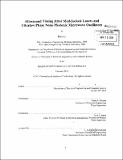Attosecond timing jitter modelocked lasers and ultralow phase noise photonic microwave oscillators
Author(s)
Li, Duo, Ph. D. Massachusetts Institute of Technology
DownloadFull printable version (11.75Mb)
Other Contributors
Massachusetts Institute of Technology. Department of Electrical Engineering and Computer Science.
Advisor
Franz X. Kartner and Erich P. Ippen.
Terms of use
Metadata
Show full item recordAbstract
Photonic microwave oscillator based on optical frequency comb and ultrastable optical reference cavity represents the state-of-the-art solution to generate X-band microwaves of ultralow phase noise. Such high-quality microwave source enables a range of applications in which frequency stability and timing accuracy are essential to performance. Wide use of this technology, however, requires compact system architecture, low-term stability and low energy consumption, which drive the needs to develop high repetition-rate femtosecond lasers alternative to Ti:sapphire technology, and to explore a feasible means to achieve integrated photonic microwave oscillators. Ultrafast Cr:LiSAF lasers can be directly pumped with low-cost red laser diodes, and the electrical-to-optical conversion efficiency is as high as 10%. High repetition-rate femtosecond Cr:LiSAF lasers are developed with the help of semiconductor saturable absorber technology, efficient dispersion compensation mirror design algorithms, and heat management of the saturable absorber. The I-GHz Cr:LiSAF oscillator generates 55-fs pulses with 110 pJ pulse energy, which represents almost two orders of magnitude improvement in the output peak power over previous results. Timing jitter of 1 00-MHz Cr:LiSAF lasers is measured with a single-crystal balanced optical cross-correlator to be -30 as from 10 kHz to 50 MHz. Pump intensity noise coupled into phase noise through the self-steepening effect proves to be the major noise source. The most recent advance in silicon photonics and wafer-scale three-dimensional integration technology illuminates a pathway toward on-chip photonic microwave oscillators. Phase noise model of the proposed Erbium Silicon Photonics Integrated OscillatoR (ESPIOR) suggests that it is possible to achieve comparable noise performance with the Ti:sapphire-based system, without the need of carrier-envelope-offset frequency detection. A demonstration using fiber-optic components further indicates that it is practicable to realize optical frequency division and microwave readout in the proposed architecture. With the advancement of heterogeneous electronic-photonic integration, it would pave the way for an ultralow-noise microwave source fully integrated in a hybrid photonic-electronic chip on a silicon substrate.
Description
Thesis: Ph. D., Massachusetts Institute of Technology, Department of Electrical Engineering and Computer Science, 2014. Cataloged from PDF version of thesis. Includes bibliographical references (pages 111-119).
Date issued
2014Department
Massachusetts Institute of Technology. Department of Electrical Engineering and Computer SciencePublisher
Massachusetts Institute of Technology
Keywords
Electrical Engineering and Computer Science.